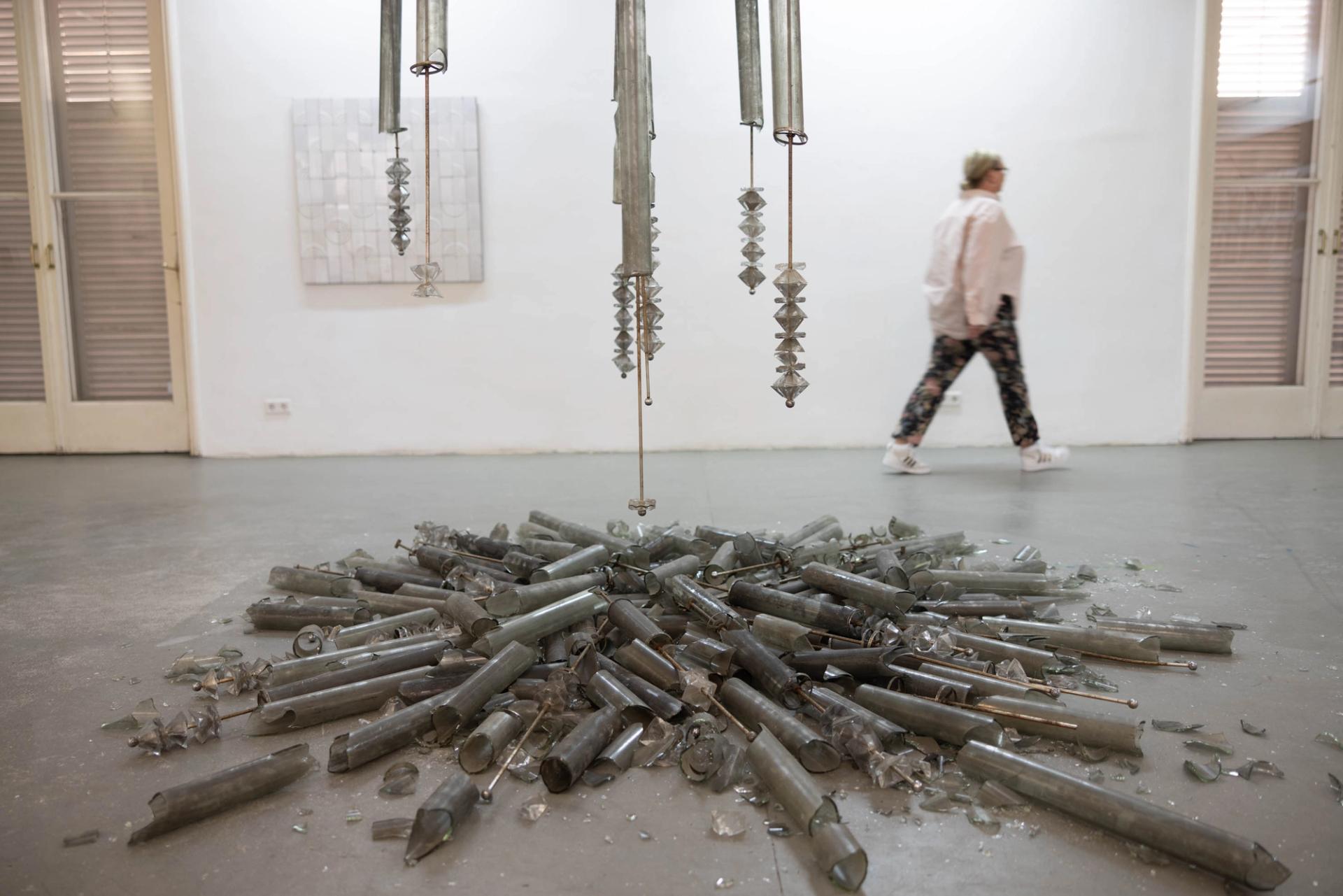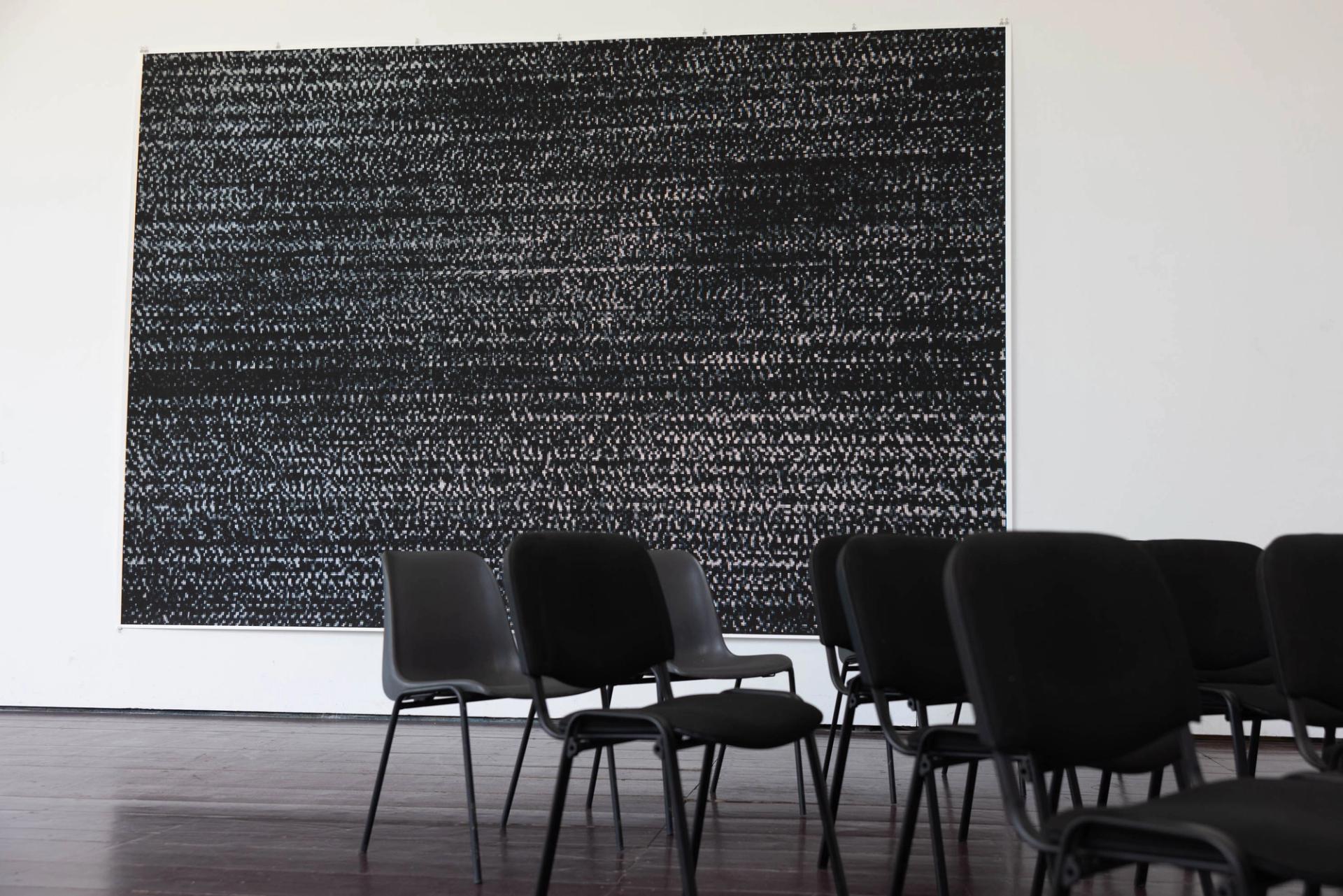The first work many visitors to the fifth Kyiv Biennial in Vienna encounter tells a story that starts two days before the Russian invasion of Ukraine, in February 2022.
“I’m absolutely not scared,” asserts one student to the camera, while another blithely plays ukulele. The video ends at 5am on 24 February, with the sound of sirens wailing.
The film, by Kharkiv-born artist Alisa Sizyk, sets a poignant tone for the biennial. The work is on view at Augarten Contemporary, the central venue of the eight across Austrian capital that are hosting the show, until 17 December.
A large number of the works assembled at Augarten speak directly to the Ukrainian war with Russia, but others address war and violence, authoritarian rule and political subjugation more broadly.
Vienna is the main venue of the Kyiv Biennial this year, which, as the result of the war, has been conceived as a pan-European event, to demonstrate that the European art world stands with the Ukrainians, with additional exhibitions occurring in cities such as Kyiv, Warsaw, Lublin and Berlin.
“We put the whole thing together in just four months as an act of solidarity,” said Georg Schöllhammer, one of the co-curators of the Vienna event.
“The idea was to reintegrate the diaspora of Ukrainian artists that is now spread across Europe, with the ones living in Ukraine still and with international colleagues who have similar experiences or have worked already with Ukraine.”
Some 2,000 artists and visitors attended the Vienna opening on October 17, said Schöllhammer, which featured live performance pieces by the Greek artist Georgia Sagri and the queer multimedia artist and musician Boji, from Kyiv.
Ukrainian artists in the show include Kateryna Lysovenko, Kateryna Aliinyk, filmmaker duo Yarema Malashchuk & Roman Hīmey, and Anton Shebtko. Featured artists from other countries include French artist Laure Prouvost, German photographer Wolfgang Tillmans, and Romanian multidisciplinary artist Dan Perjovsskhi.
Co-curators Schöllhammer and Hedwig Saxenhuber worked with Kyiv Biennial curator and managing director, Serge Klymko, on the Vienna exhibition. They previously co-hosted the first Kyiv Biennial in 2015 with the non-profit Kyiv Visual Culture Research Centre.
The team made the decision to mount the Viennese show in May, and organised it hastily, and with all the complications of moving artworks out of a war zone. “It was really a complicated process to get works out of Ukraine,” said Saxenhuber, “but we succeeded in finding a way.”
The largest collection of works in Vienna, totalling around 30, is displayed at the Augarten, a sprawling studio with sun roofs that let in ample light. Schöllhammer described it as a “contaminated space,” because it was a former atelier for an Austrian sculptor who made Nazi monuments during World War II.
A second location, Never At Home art space, contains a large number of works that focus on the LGBTQ community in Kyiv, both before and during the war. New media works, including virtual reality installations, are featured at the Neuer Kunstverein Wien.

Salute (2022) by the Ukrainian art group De Ne De brings a badly-damaged chandelier from a Kyiv hotel into the exhibition space
Photo: eSeL.at - Lorenz Seidler
Many of the works on display explore ways of holding together fragments of the country the artists were forced to leave. At Augarten, Salute (2022) by the Ukrainian art group De Ne De features a badly-damaged brutalist chandelier from a Soviet-era cinema in Dnipro called The Salute. To rescue the broken chandelier from Ukraine organisers had to label it as “theatre sets,” Saxenhuber says.
Two acrylic paintings by Aliinyk from 2022, Neglected Part of the Garden and Ukrainian River, feature the landscape of Donbas littered with artillery shells and shrapnel.

Aliinyk's 2022 paintings Neglected Part of the Garden and Ukrainian River show the landscape of Donbas impacted by war
Photo: eSeL.at - Lorenz Seidler
Prouvost's five-part video installation is shown on TV monitors that are covered with cloth or turned towards the floor or wall so that they’re nearly impossible to view, suggesting something unwatchable or intentionally obscured. Tillmans presents a large 2014 inkjet print depicting what looks like television static, while also giving space to photojournalist Friedrich Bungert's photos of wounded Ukrainian fighters.

Tillmans presents Weak Signal IV, a large-scale inkjet print from 2014
Photo: eSeL.at - Lorenz Seidler
A massive LED light installation, There is an Elephant in the Room (2019), by the Danish art collective, SUPERFLEX, merely comments on the reality of the situation. At the Never at Home space, meanwhile, Colombian collage artist Daniel Otero Torres has created a sculpture that combines images from historic conflict zones including the Vietnam War and the Algerian War, made in meticulous pencil drawings on polished stainless steel.
“There was such a strong movement between the people to bring their works and to share their ideas,” Saxenhuber says. “I have never experienced it before.”
Whether their works directly address the Russia-Ukraine war or other international conflicts, all the artists involved have some experience with the violence of political aggression.
“You can see the conflict,” Saxenhuber says. “This undertone of the war is always there.”


